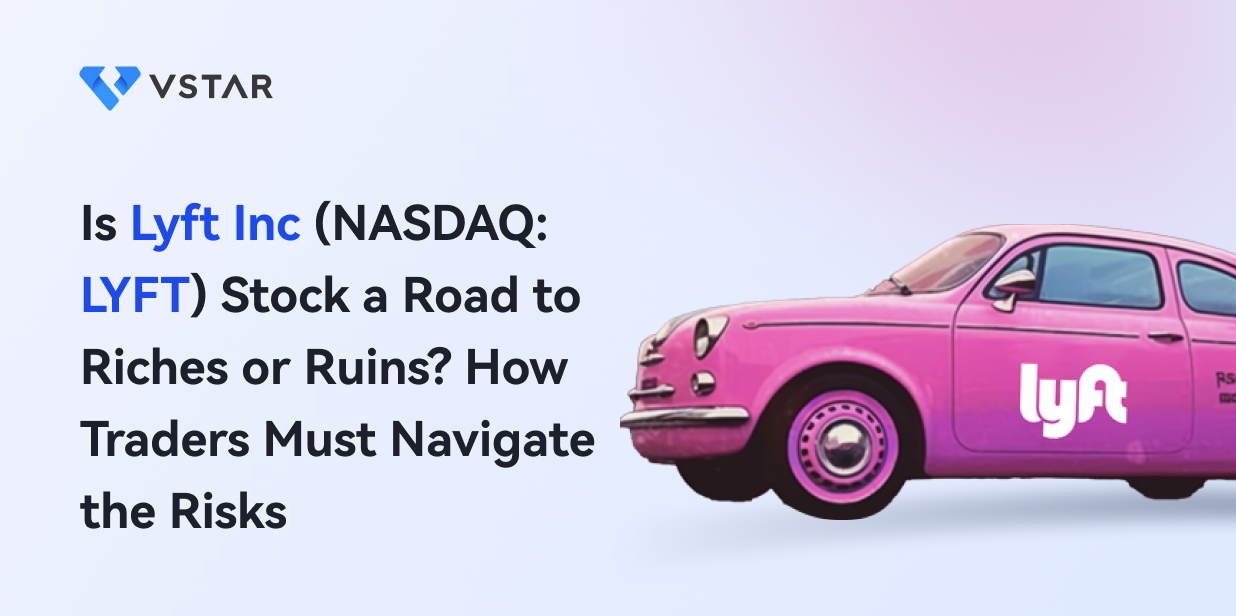If you’re considering investing in Lyft Inc (NASDAQ: LYFT), it helps to survey the ground first to determine if LYFT stock is a good fit for you.
Lyft stock price has retreated sharply from its all-time high of $88.60 to just over $8 now. That represents a 90% slide from the peak. Should you look at the pullback as a bargain opportunity to buy Lyft stock at a steep discount or a warning to stay away from this rideshare stock?
This article will help you determine whether Lyft stock is a good investment. The article explores Lyft’s business model, financials, challenges, and opportunities. You’re also going to find out the Lyft stock forecast.
Is Lyft (NASDAQ: LYFT) a Buyout Target?
Rumors have swirled for a while that Lyft could be a takeover target. Many have mentioned that Lyft could draw acquisition interests from companies like Amazon (NASDAQ: AMZN), Google parent Alphabet (NASDAQ: GOOGL), General Motors (NYSE: GM), and Ford Motor (NYSE: F).
If you’re weighing investing in Lyft stock, the possibility of the company being bought out is something you should have in mind. Buyouts can provide premium exits for investors.

*Source: Lyft
The recent executive changes at Lyft (NASDAQ: LYFT) have revived the buyout rumors. Lyft’s founders stepped back from executive roles in the company in the shakeup. The management overhaul saw former Microsoft (NASDAQ: MSFT) and Amazon executive David Risher brought in as Lyft CEO and former Charles Schwab executive Erin Brewer tapped for the CFO role.
Many believe that all options are on the table for Lyft after the executive shakeup that removed the company’s founders from the driver’s seat. While Lyft’s fresh executive team has talked much about turning around the business, a potential sale of the company is among the options thought to be on the table.

*Source: Pexels.com
Lyft stock has previously rallied on buyout rumors. Whether Lyft is going to be bought or continue as an independent company, it helps to get to know the company. After all, a top Warren Buffett advice is that you should only invest in businesses that you understand well. With that in mind, let’s get to know Lyft in a little more detail.
Lyft Inc (NASDAQ: LYFT) Overview
Lyft provides on-demand transport service, or ride-hailing. It is Uber’s biggest competitor in the U.S. rideshare market. Founded in 2012, Lyft is headquartered in San Francisco, California, and operates in the U.S. and Canada.

*Source: Unpslash.com
Lyft became the first publicly traded ride-hailing company, ahead of rival Uber Technologies Inc (NYSE: UBER). Lyft CEO David Risher took over the top role at the ride-hailing company in April 2023. Erin Brewer is scheduled to take over as Lyft CFO in July.
|
About Lyft Stock |
|
|
Former name |
Zimride |
|
Year Founded |
2012 |
|
Founders |
Logan Green and John Zimmer |
|
CEO |
David Risher (2023) |
|
Headquarters |
San Francisco, California, US |
|
Industry |
On-demand transport (ride-hailing) |
|
IPO Year |
2019 |
|
Milestone |
First ride-hailing company to IPO |
Lyft’s Business Model and Services
The company’s business is about helping people get around. It operates an app that connects riders with drivers. People can request a ride through the Lyft app to the airport, office, store, or doctor’s office. Lyft takes a cut of the fare that riders pay to drivers on its platform.
The company also offers car rental services in partnership with Hertz and Sixt. In addition to cars, Lyft rents out bikes and scooters.

*Source: Lyft
Lyft also delivers meals from restaurants and operates service centers where drivers can go to get their cars fixed for a fee. Additionally, the company provides advertising where brands can place ads on Lyft cars and Lyft bike docking stations. Therefore, Lyft has multiple revenue streams.
Lyft’s Financial Performance
Lyft’s financial year aligns with the calendar, beginning in January and ending in December. Here’s a look at Lyft’s financial performance:
Revenue
Lyft’s revenue increased about 28% to $4.1 billion in 2022, marking the company’s highest topline figure since the IPO. Lyft’s revenue jumped 36% in 2021. Except in 2020 when the Covid-19 pandemic lockdowns virtually wiped out ride demand, Lyft has consistently delivered strong annual revenue growth. The company’s revenue has increased at a compound annual growth rate of 14% over the past 5 years.
The chart below illustrates Lyft’s annual revenue trend.
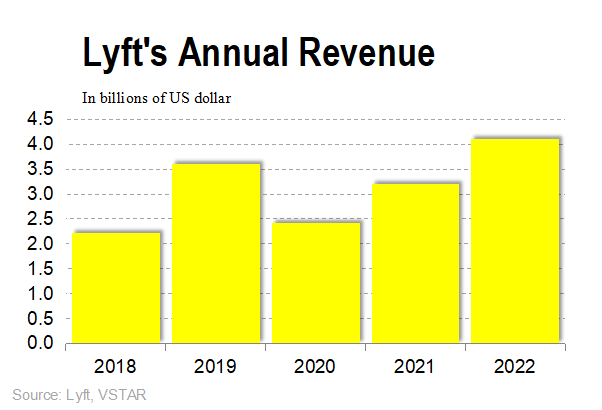
Lyft’s revenue rose 14% to $1 billion in the first quarter of 2023. The company’s 2023 annual revenue is forecast to grow about 5% to $4.3 billion.
Net Income
The ride-hailing provider is still aiming to turn a profit. Lyft made a net loss of $1.58 billion in 2022, which widened from a loss of $1.1 billion in 2021 but narrowed from a loss of $1.75 billion in 2020. If first quarter results are any indicator, 2023 could be a better year for Lyft’s bottomline. The company’s net loss narrowed sharply to $188 million in Q1 2023, compared to a loss of $588 million the previous quarter and a loss of $196 million in the same period a year ago.
Profit Margin
Lyft’s gross profit margin was 40.5% in 2022. The company has maintained an annual gross margin of more than 37% over the past 5 years.
The company's largest cost item is the cost of revenue, which encompasses the cost of hosting its platform on the cloud and the cost of processing payments. Marketing, research and developments, and administrative expenses are the company’s other major cost items.
To bolster its profit margins and improve its bottomline, Lyft has made cost-cutting a major focus. Soon after it hired a new CEO, Lyft revealed plans to slash its workforce by about 26%. Moreover, the company has decided to freeze hiring in some areas as part of the cost control efforts.
Cash Position and Balance Sheet Condition
Although Lyft is losing money in its operations, it has a sizable amount of cash to keep it going. The company ended Q1 2023 with about $740 million in cash and cash equivalents.
The company’s balance sheet is also solid, showing $4.5 billion in assets and only $793 million in long-term debt. Should it require more money, Lyft could easily raise additional cash by selling shares of raising debt.
Lyft (NASDAQ: LYFT) Stock Performance
Lyft shares are listed on the NASDAQ exchange and trade under the “LYFT” ticker symbol.
|
About Lyft Stock Price |
|
|
IPO price |
$72 |
|
Marketed IPO price range |
$70 - $72 |
|
All-time high |
$88.60 |
Lyft (NASDAQ: LYFT) stock went public in March 2019 at an IPO price of $72. The deal raised more than $2.3 billion and valued the ride-hailing company at more than $24 billion. It was a fairly strong debut for LYFT stock as it rose as much as 23% on its first trading. The stock went on to hit its all-time high of $88.60 shortly after the IPO.
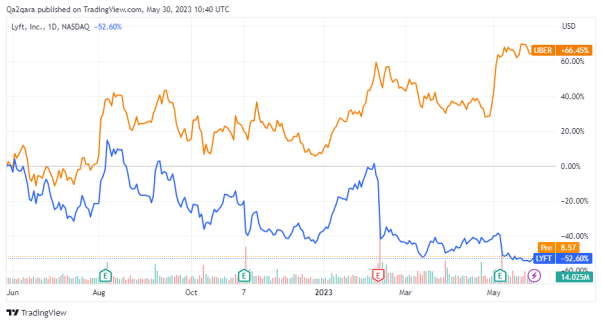
Looking back, LYFT stock has retreated more than 80% from its IPO price and 90% from its all-time high. The stock has declined about 25% year-to-date and retreated 50% over the past year. In contrast, Uber has gained 50% year-to-date and 65% over the past year.
Why Is LYFT Stock Going Down?
Depending on how you look at it, the pullback in LYFT stock may be a bargain opportunity or warning sign to stay away. Understanding why Lyft stock has dropped sharply from its high can help you make an informed decision.
Lyft’s persistent losses and signs of slowing growth can explain the stock’s steep decline. If you look at the recent events at the company, you get an impression that these problems are temporary.
On losses, Lyft’s new executive team has made improving the company’s operational efficiency a top priority. To drive that message home, the company has already decided to shrink its workforce to control costs. That is a step in the right direction in the efforts to get Lyft out of losses.
On revenue growth, the driver shortage has been a major issue for Lyft since the Covid-19 pandemic hit. Consequently, the company has been leaving money on the table to competitors. But Lyft has plenty of room to grow its sales as it resolves the driver shortage issue, expands its service portfolio, and enters into new markets.
Lyft Stock Forecast
Wall Street’s average 12-month Lyft stock target of $11.36 suggests more than 35% upside potential. The peak Lyft (NASDAQ: LYFT) stock forecast of $23 implies as much as 175% upside. And LYFT stock’s lowest price target of $8.50 indicates that further downside in the stock is limited.
These are some of the key drivers of LYFT stock price:
Financial performance:Lyft’s financial performance is investors’ greatest focus. As a result, the stock soars when investors perceive the performance to be strong and falls when investors perceive the results as weak.
Company news:Lyft’s stock tends to rise on announcement of partnerships and product rollouts that investors believe can lead to more revenue for the company. Lyft stock also tends to be sensitive to executive changes. It can rise when investors view the changes favorably and fall when investors disapprove of the changes.
Buyout rumors:Many investors believe that Lyft will eventually be bought by another company. As a result, buyout rumors tend to move LYFT stock. Investors tend to pile into the stock whenever they think a takeover bid is in the offing for the ride-hailing provider.
Lyft’s Challenges and Opportunities
Driving revenue growth and improving operational efficiency are top priorities for Lyft’s management as the company begins to take concrete steps toward turning a profit. The success in these efforts will depend on how well the company navigates its challenges and takes advantage of the opportunities.
Let’s examine the risk and challenges facing Lyft Inc (NASDAQ: LYFT) and the opportunities ahead for the company.
Lyft’s Risks and Challenges
Driver relationship:Lyft is under pressure to maintain a good relationship with its drivers to ensure a reliable service and to protect its reputation. The problem is that Lyft may be forced to make concessions to accommodate drivers’ demands at the expense of its bottomline or at the risk of annoying the riders.
Regulations:For their business model to work, Lyft and other rideshare providers treat their drivers as independent contractors rather than employees. The classification of rideshare drivers as contractors has been a source of controversy in many places. This situation poses a regulatory risk for Lyft.
Competition:Lyft’s greatest threat is competition. Since the ride-hailing business has low barriers to entry, there is a risk of the market crowding with competitors. While Uber is Lyft’s biggest competitor Uber, the company also faces competition from a host of little rivals such as Wingz, Via, and Curb.
Lyft’s Competitive Advantages
While there is little that Lyft Inc (NASDAQ: LYFT) can do to avoid competition, the company has a chance to fight and succeed. These are some of Lyft’s competitive advantages:
|
Competitive advantages |
Details |
|
Strong brand |
Lyft is one of the most recognized and trusted brands in the ride-hailing market. It could take newcomers to the rideshare business many years to rise to Lyft’s brand position. |
|
Strong financial position |
With $740 million in cash and cash equivalents and a minimal debt relative to assets, Lyft is in a far much better financial position than many of its competitors. |
|
Diversified business |
Although Lyft is best-known for its ride-hailing service, the company has diversified into other businesses. With a diversified operation, Lyft has spread its risks better than many of its rivals. |
|
Low forex risks |
Lyft has so far confined its operations to the U.S. and Canada. In contrast, Uber operates in more than 70 countries. Lyft’s limited international footprint means low exposure to foreign currency exchange risks. |
Lyft’s Opportunities
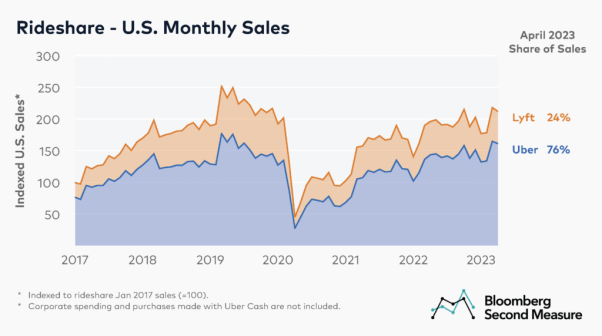
*Source: Second Measure
Although Lyft (NASDAQ: LYFT) already ranks as the second-largest ride-hailing provider in the U.S. with 26% market share, it still has plenty of room to grow.
While displacing Uber as the ride-hailing king may be a tall order for Lyft, it has an opportunity to cut into the rival’s market share. These are some of Lyft’s growth and profit opportunities:
International expansion:Although Lyft has so far concentrated its business in the U.S. and Canada, nothing stops it from going into more international markets. With Lyft’s new executive team pledging to turn around the business, perhaps the company could look to expand abroad for more growth.
Membership subscription:Lyft offers a rider subscription program that comes with benefits such as priority pickup and free food delivery. As Amazon’s Prime program has demonstrated, membership subscriptions can be successful tools for building customer loyalty and upselling customers to capture a larger share of their spending.
Advertising business:Lyft has set up a media unit through which it offers advertising service. Brands can place ads on a Lyft car’s rooftop screen, in-car tablet displays, and at bike docking locations. Seeing how Google and Facebook have made billions from selling ads, this business presents a huge revenue opportunity for Lyft.
Autonomous cars:Lyft has started deploying driverless cars for its ride-hailing service. Self-driving cars can help the company cut costs to improve its profitability. Additionally, autonomous cars can help the company solve the problem of driver shortage.
Lyft’s Addressable Market Size
Ride-hailing remains Lyft’s primary business even as it continues to diversify into other services. Lyft’s addressable rideshare market size in North America is forecast to reach $24 billion in 2028, from $12.6 billion in 2021.
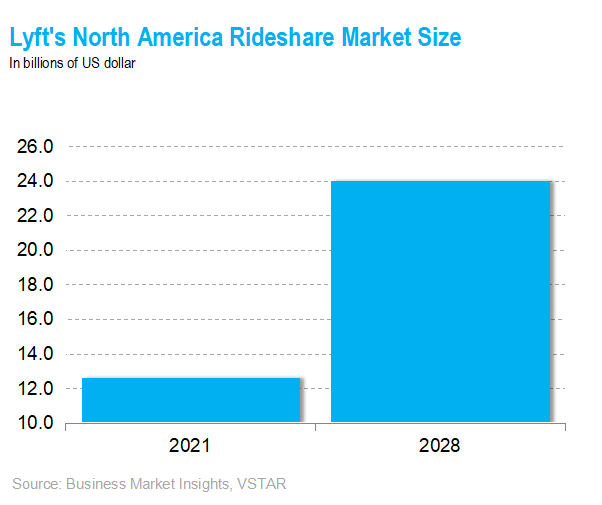
How to Invest in LYFT Stock
Depending on your investment timeline, amount of capital, and risk tolerance, you can make money with Lyft stock in various ways. Let’s look at the three popular ways you can invest in LYFT stock.
1. Holding LYFT Shares
Buying and holding shares in a company is the traditional investment method. In this investment method, you buy Lyft shares and hold them for months or years. Your hope is that Lyft’s stock price would have appreciated at the end of your investment timeline to allow you to make a profit.
Although holding Lyft shares offers benefits such as shareholder voting rights and eligibility for potential dividends, this investment method requires a large initial capital and long wait for returns.
2. Trading LYFT Stock Options
Stock options give you the right to buy or sell a stock at a future date. There are two types of options: Call options and Put options.
If you expect the LYFT stock price to appreciate, you purchase a call option. This option gives you the right to buy Lyft shares at a discount price in the future. For example, you can purchase a “call option” that allows you to buy Lyft stock at $8 in a month from now even if the stock’s price would have gone up to $12 at that time.
On the other hand, you purchase a LYFT stock “put option” if you expect the stock to decline. This option gives you the right to sell Lyft shares at a premium price in the future. For example, you can purchase a put option that allows you to sell LYFT stock at $8 in a month’s time even if the stock’s actual price by that time would have gone down to say $6.
Although options allow you to lock in favorable prices for your future trade, it comes with several requirements that can be a burden to traders with little money to start with. For example, a stock option involves a package of 100 shares, which can require a large starting capital. Additionally, options trading requires putting down a deposit that you must forfeit if you fail to use your option. Therefore, you have little control of the capital you can invest in options trading.
3. Trading LYFT Stock CFD
Stock CFD trading offers a more flexible and less burdening way to make money with LYFT stock. As a middleground investment method, CFD trading combines the best attributes of holding shares and trading options.
In CFD trading, you speculate on stock price movements. If you expect Lyft stock price to rise, you trade a CFD contract that pays you the price increase. If you expect the stock to decline, you trade a CFD contract that pays you the price decrease.
As you can see, CFD trading allows you to make money both when Lyft stock is going up and when it is going down. Moreover, this strategy requires less starting capital than holding shares or trading options. CFD trading is best for capturing short-term profit from stock price fluctuation.
Why Trade LYFT Stock CFD With VSTAR
If you prefer trading Lyft stock CFD, VSTAR is an excellent CFD trading platform to use. These are the reasons VSTAR has popular with CFD traders:
Low starting capital: You can start trading Lyft stock CFD on VSTAR with as a little as $50.
Low trading costs:VSTAR offers tight bid-ask spreads and low trading fees to maximize your profit.
High-speed trades:VSTAR supports real time trading with ultrafast order execution.
Leverage:If you have a low starting capital, VSTAR offers leverage to boost your trade.
Risk management:VSTAR offers limit and stop order features to help you manage your risks and protect your gains.
Human support:Should you need help while trading on VSTAR, you can access human support at any market time.
Credible platform:VSTAR is a fully licensed and regulated CFD trading platform.
How to Trade LYFT Stock CFD With VSTAR
It takes only a few steps to start trading Lyft stock CFD on VSTAR.
Open VSTAR account– You can use an email address or phone number to register.
Fund the account – VSTAR supports all popular deposit methods, including credit cards, bank transfer, and digital wallets.
Start trading– You can start trading LYFT stock CFD as soon as your account is approved and funded.
For new traders, VSTAR offers a demo account with up to $100,000 in virtual money for your trading practice.
Lyft Stock CFD Trading Tips to Help You Maximize Profitability
Should I invest in Lyft stock? Is Lyft stock a good investment? Is Lyft stock a buy or sell? If any of these questions has come to your mind, signs are that you’re a cautious investor wanting to make the right move.
Trading stock CFDs can be risky, but those who excel in this trade know that proper timing rewards. CFD trading can be highly profitable if you know the right time to enter or exit a trade. Here’re 3 tips to help you develop a successful trading strategy for the Lyft stock CFD.
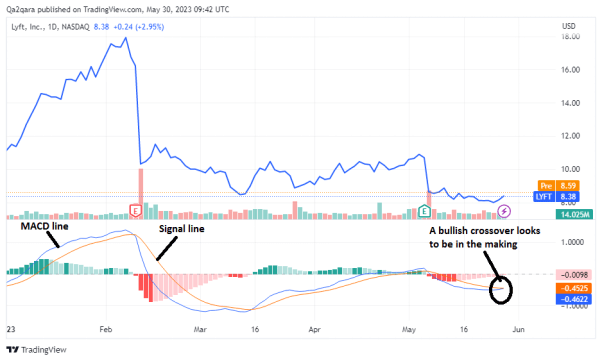
1. Study MACD Crossovers
In the Moving Average Convergence Divergence (MACD) chart, look for MACD line and signal line crossovers. If you see Lyft stock’s MACD line cross above the signal line, it signals a possible uptrend from the current level.
On the other hand, if Lyft stock’s MACD line crosses below the signal line, it indicates a possible downtrend. As you can see from the Lyft stock chart above, the MACD line looks to be about to cross over the signal line.
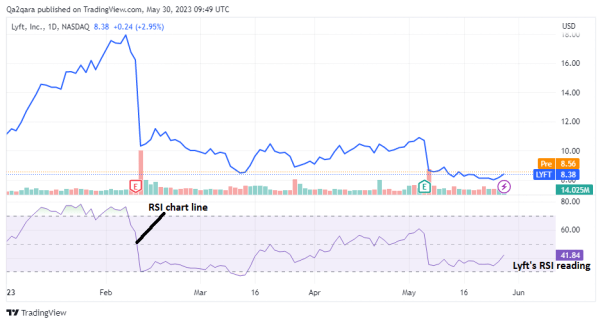
2. Study RSI Reading
The Relative Strength Index (RSI) shows you whether a stock is overbought or oversold. The RSI reading comes in the range of 0 – 100. If the RSI is above 70, it indicates that the stock has climbed too high and is likely to drop from its current level.
An RSI reading below 30 suggests the stock has dropped too low and is likely to rise from its current level. From the chart above, you can see that Lyft stock has an RSI reading of about 42, which suggests that the stock has potential to rise from its current level.
3. Look For Support and Resistance Levels
If you’re betting on a price increase, look to trade LYFT stock CFD when the price is at the support level. If you’re betting on a price decrease, look to trade LYFT stock CFD when the price is at the resistance level.
Final Thoughts
Lyft Inc (NASDAQ: LYFT) stock price has dropped steeply from its highs amid concerns about the company’s persistent losses and slowing revenue growth. But with the recent management overhaul, Lyft looks poised for a major turnaround, or the company could be a more appealing buyout target. If that is so, then the stock looks to be a big bargain now.
